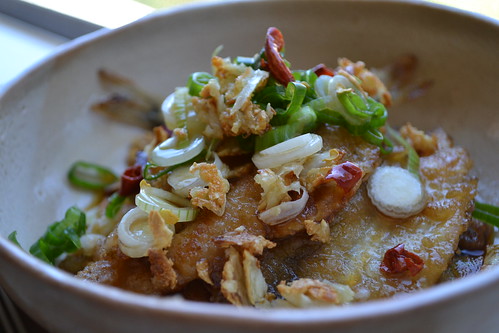
Smelt. Fried, they are a great accompaniment to a pint of beer. Grilled and served with a bowl of white rice, they complete a Japanese breakfast. They also win the Cheap Bastards' Choice Award, since they average $3.50/lb.
The "Wakasagi" variety of smelt were introduced from Japan to the San Francisco delta in 1959 as a forage fish. This was back when they thought that the "wakasagi" smelt and native "California-delta" smelt were the same species. Oops, they were wrong. And now the
wakasagi (aka
Hypomesus nipponensis) are more successful in the delta waters than their OG cousins. Asian invasion.
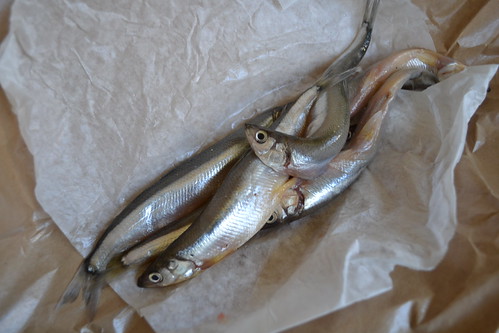
In the past, I've prepared
wakasagi in a number of ways including grilling and pan-frying them. I decided I wanted to jazz them up a little and made my own interpretation of
wakasagi nanban.
Nanban is a method of preparation which involves frying and using a sweet and sour sauce for marination.
My concept for the dish is "special, yet comforting." Although I can eat bones in small fish, it is a luxury when I don't have to deal with them. I like to eat with confidence, which means not worrying about getting a tiny bone stuck in my throat. So for this dish, I decided to fillet them. The comfort was provided by the
nanban sauce--a familiar taste in Japanese cooking using sugar, vinegar and a hint of red pepper.
Most of the recipes I introduce on
Japanify are really easy. But I am not going to lie to you about this one. The steps are numerous and I ended up with a lot of dishes to wash.
Wakasagi Smelt in Nanban Sauce
INGREDIENTS
6-8
Wakasagi smelt, filleted
4 cloves garlic, minced
1 green onion stalk chopped fine
1/2 cup potato starch
Marinade
1 1/2 tbsp grated ginger
2-3 tbsp soy sauce
1-2 cooking oil
Nanban Sauce
1 tsp sugar
2 tbsp soy sauce
4 tbsp
rice vinegar
1 dried red pepper, chopped fine
3 tbsp sesame oil
pepper
METHOD
1. Combine the ingredients for the marinade.
2. Combine the ingredients for the
nanban sauce.
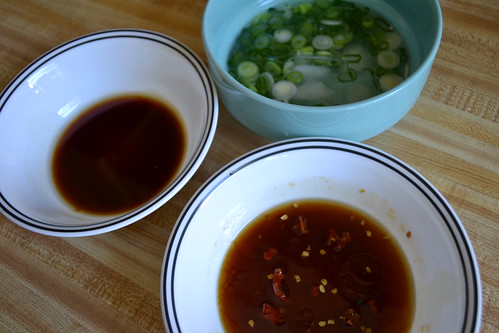
3. Fillet the fish. Place in marinade for at least 10 minutes.
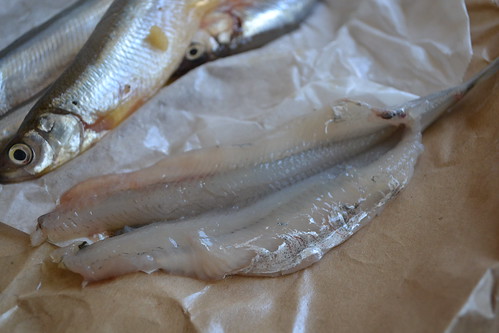

4. Fry the garlic with some oil.

5. Combine starch and pepper into a medium-sized bowl. Coat the fish with the starch.
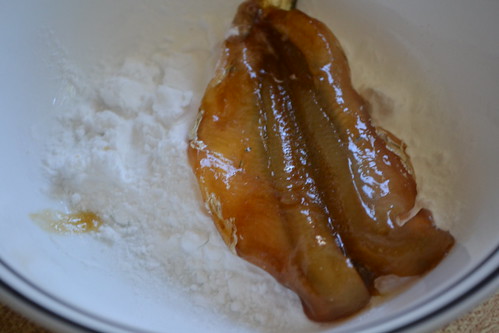
6. Coat a pan with oil. Once the oil is hot, place the fish skin side down onto the pan. Fry each side for 1-2 minutes.
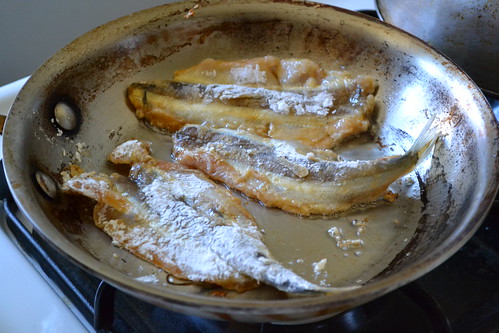
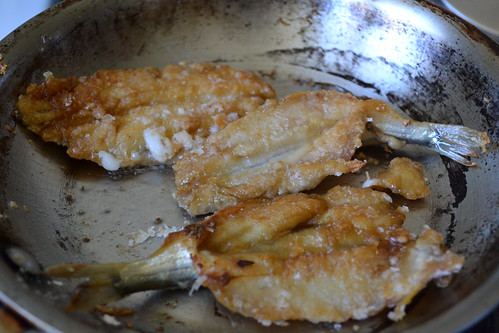
7. Plate the fish. Garnish with green onions and fried garlic.
9. Spoon the
nanban sauce over the fish.
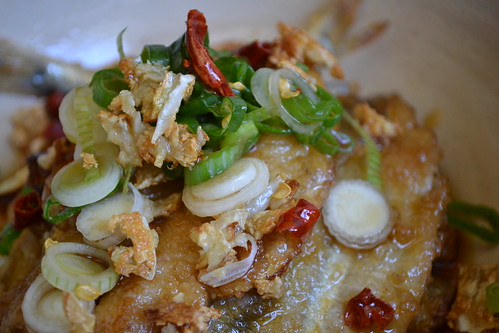
The concept of "special, yet comforting" was carried out successfully. It was kind of luxurious not having to deal with any tiny bones and the sauce was pleasantly familiar. One of my recent obsessions is to lightly pan-fry fish and then draping it with sauce. Doing this creates a wonderful contrast between crispy and saturated.

This is a great dish to make in bulk because the materials are inexpensive and the fruits of your labor will be appreciated by many.
 Smelt. Fried, they are a great accompaniment to a pint of beer. Grilled and served with a bowl of white rice, they complete a Japanese breakfast. They also win the Cheap Bastards' Choice Award, since they average $3.50/lb.
The "Wakasagi" variety of smelt were introduced from Japan to the San Francisco delta in 1959 as a forage fish. This was back when they thought that the "wakasagi" smelt and native "California-delta" smelt were the same species. Oops, they were wrong. And now the wakasagi (aka Hypomesus nipponensis) are more successful in the delta waters than their OG cousins. Asian invasion.
Smelt. Fried, they are a great accompaniment to a pint of beer. Grilled and served with a bowl of white rice, they complete a Japanese breakfast. They also win the Cheap Bastards' Choice Award, since they average $3.50/lb.
The "Wakasagi" variety of smelt were introduced from Japan to the San Francisco delta in 1959 as a forage fish. This was back when they thought that the "wakasagi" smelt and native "California-delta" smelt were the same species. Oops, they were wrong. And now the wakasagi (aka Hypomesus nipponensis) are more successful in the delta waters than their OG cousins. Asian invasion.
 In the past, I've prepared wakasagi in a number of ways including grilling and pan-frying them. I decided I wanted to jazz them up a little and made my own interpretation of wakasagi nanban. Nanban is a method of preparation which involves frying and using a sweet and sour sauce for marination.
My concept for the dish is "special, yet comforting." Although I can eat bones in small fish, it is a luxury when I don't have to deal with them. I like to eat with confidence, which means not worrying about getting a tiny bone stuck in my throat. So for this dish, I decided to fillet them. The comfort was provided by the nanban sauce--a familiar taste in Japanese cooking using sugar, vinegar and a hint of red pepper.
Most of the recipes I introduce on Japanify are really easy. But I am not going to lie to you about this one. The steps are numerous and I ended up with a lot of dishes to wash.
Wakasagi Smelt in Nanban Sauce
INGREDIENTS
6-8 Wakasagi smelt, filleted
4 cloves garlic, minced
1 green onion stalk chopped fine
1/2 cup potato starch
Marinade
1 1/2 tbsp grated ginger
2-3 tbsp soy sauce
1-2 cooking oil
Nanban Sauce
1 tsp sugar
2 tbsp soy sauce
4 tbsp rice vinegar
1 dried red pepper, chopped fine
3 tbsp sesame oil
pepper
METHOD
1. Combine the ingredients for the marinade.
2. Combine the ingredients for the nanban sauce.
In the past, I've prepared wakasagi in a number of ways including grilling and pan-frying them. I decided I wanted to jazz them up a little and made my own interpretation of wakasagi nanban. Nanban is a method of preparation which involves frying and using a sweet and sour sauce for marination.
My concept for the dish is "special, yet comforting." Although I can eat bones in small fish, it is a luxury when I don't have to deal with them. I like to eat with confidence, which means not worrying about getting a tiny bone stuck in my throat. So for this dish, I decided to fillet them. The comfort was provided by the nanban sauce--a familiar taste in Japanese cooking using sugar, vinegar and a hint of red pepper.
Most of the recipes I introduce on Japanify are really easy. But I am not going to lie to you about this one. The steps are numerous and I ended up with a lot of dishes to wash.
Wakasagi Smelt in Nanban Sauce
INGREDIENTS
6-8 Wakasagi smelt, filleted
4 cloves garlic, minced
1 green onion stalk chopped fine
1/2 cup potato starch
Marinade
1 1/2 tbsp grated ginger
2-3 tbsp soy sauce
1-2 cooking oil
Nanban Sauce
1 tsp sugar
2 tbsp soy sauce
4 tbsp rice vinegar
1 dried red pepper, chopped fine
3 tbsp sesame oil
pepper
METHOD
1. Combine the ingredients for the marinade.
2. Combine the ingredients for the nanban sauce.
 3. Fillet the fish. Place in marinade for at least 10 minutes.
3. Fillet the fish. Place in marinade for at least 10 minutes.

 4. Fry the garlic with some oil.
4. Fry the garlic with some oil.
 5. Combine starch and pepper into a medium-sized bowl. Coat the fish with the starch.
5. Combine starch and pepper into a medium-sized bowl. Coat the fish with the starch.
 6. Coat a pan with oil. Once the oil is hot, place the fish skin side down onto the pan. Fry each side for 1-2 minutes.
6. Coat a pan with oil. Once the oil is hot, place the fish skin side down onto the pan. Fry each side for 1-2 minutes.

 7. Plate the fish. Garnish with green onions and fried garlic.
9. Spoon the nanban sauce over the fish.
7. Plate the fish. Garnish with green onions and fried garlic.
9. Spoon the nanban sauce over the fish.
 The concept of "special, yet comforting" was carried out successfully. It was kind of luxurious not having to deal with any tiny bones and the sauce was pleasantly familiar. One of my recent obsessions is to lightly pan-fry fish and then draping it with sauce. Doing this creates a wonderful contrast between crispy and saturated.
The concept of "special, yet comforting" was carried out successfully. It was kind of luxurious not having to deal with any tiny bones and the sauce was pleasantly familiar. One of my recent obsessions is to lightly pan-fry fish and then draping it with sauce. Doing this creates a wonderful contrast between crispy and saturated.
 This is a great dish to make in bulk because the materials are inexpensive and the fruits of your labor will be appreciated by many.
This is a great dish to make in bulk because the materials are inexpensive and the fruits of your labor will be appreciated by many.




Comments (10)
holy crap, that looks so delicious! must try this at home. do you think corn starch work instead of the potato starch?
Not many people can’t read this, but Yoko, a new challenge for you. http://kisyoku.info/wk.htm
This looks SO good. I’m not sure about the wakachoco though…
Yoko, I can’t believe you use All Clad to fry fish! I’ve always used teflon for fish. You can use Barkeeper’s friend to clean All Clad, it will make the pan look brand new!
How, exactly, do you fillet the fish? I hope they aren’t as hard to fillet as anchovies.
drooling.
Yamahomo! Yes, I was wondering if I was doing something wrong, frying my fish with All Clad. So I try to use the small one that I don’t use much for frying fish since it gets all dingy and burnt. I will DEFINITELY try Barkeepers friend to clean it. When I moved back to the states, my mom gave us an All Clad set as a gift and I don’t have anything else. I shall invest in a teflon pan. Frying fish has also been something new for me…
Worm – filleting the smelt was easy. After I gut it. I pulled the “spine” all the way from the head to the tail. It kind of slides right off the meat. Sometimes the meet sticks to the spine, in that case, guide it along with your finger. If there is a better way to explain it, please someone (yamahomo) jump in.
Seri – Cornstarch should work. But it will give you a more crispy crisp, Chuuka style than the potato starch… which is more light and “saku saku” than “kari kari.”
Yamahomo – forgot to comment on the WakaChoco. I bet it’s good. I remember when I first saw Royce’ chocolate covered potato chips and thought it was the most disgusting thing!! How could someone make that. But when I tried it (cuz I try everything – even though I might think it’s disgusting), it was severely delicious. Now, potato chip to fish is kind of a big jump, but fish and chocolate are two very tasty things and they might just work together. Don’t people eat bacon and chocolate too?
Thanks, Yoko! I’ll try potato starch if I remember to buy it.
Also, if you get a nonstick pan, consider the scanpan ctx. It’s not cheap, but it’s nonstick w/o using teflon so you can use metal utensils and get a sear on meats/fish. I have this one: http://amzn.to/lFQVov and it’s great!
This looks amazing!! I wish I could have this for dinner right now!